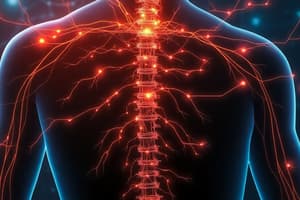Podcast
Questions and Answers
Which of the following structures is responsible for receiving incoming stimuli in a neuron?
Which of the following structures is responsible for receiving incoming stimuli in a neuron?
- Cell body
- Terminal buttons
- Axon
- Dendrites (correct)
What is the function of the Schwann cells in nerve fibers?
What is the function of the Schwann cells in nerve fibers?
- Form the myelin sheath (correct)
- Produce neurotransmitters
- Conduct electrical impulses
- Receive signals from sensory receptors
Which of the following is NOT a feature of a synapse?
Which of the following is NOT a feature of a synapse?
- Neurotransmitters bind to receptors on the postsynaptic membrane
- Neurotransmitters are released via exocytosis
- Synapses are formed by the direct fusion of two neurons (correct)
- Synapses allow communication between neurons
What is the function of the spinal ganglion (dorsal root ganglion)?
What is the function of the spinal ganglion (dorsal root ganglion)?
Which of the following statements correctly describes the function of efferent fibers?
Which of the following statements correctly describes the function of efferent fibers?
Which of the following accurately describes the function of Meissner's corpuscles?
Which of the following accurately describes the function of Meissner's corpuscles?
Which of the following statements is TRUE regarding unmyelinated nerve fibers?
Which of the following statements is TRUE regarding unmyelinated nerve fibers?
What is the primary function of the gray matter in the spinal cord?
What is the primary function of the gray matter in the spinal cord?
Which of these sensory receptors is responsible for detecting tissue stretch?
Which of these sensory receptors is responsible for detecting tissue stretch?
Which component of a reflex arc is directly responsible for muscle contraction or relaxation?
Which component of a reflex arc is directly responsible for muscle contraction or relaxation?
Flashcards
Unmyelinated Nerve Fibers
Unmyelinated Nerve Fibers
Nerve fibers without myelin, resulting in slower conduction speed.
Myelinated Nerve Fibers
Myelinated Nerve Fibers
Nerve fibers surrounded by myelin, enabling faster signal transmission.
Meissner's Corpuscles
Meissner's Corpuscles
Rapidly adapting mechanoreceptors that detect changes in pressure.
Gray Matter
Gray Matter
Signup and view all the flashcards
Reflex Arc
Reflex Arc
Signup and view all the flashcards
Central Nervous System (CNS)
Central Nervous System (CNS)
Signup and view all the flashcards
Spinal Nerves
Spinal Nerves
Signup and view all the flashcards
Myelination
Myelination
Signup and view all the flashcards
Synapse
Synapse
Signup and view all the flashcards
Dorsal Root Ganglion
Dorsal Root Ganglion
Signup and view all the flashcards
Study Notes
The Nervous System
- Consists of central (CNS) and peripheral (PNS) systems
- The CNS includes the brain and spinal cord
- The PNS extends throughout the body
The Spinal Cord
- Encased in the vertebral column
- Protected by three membranes: dura mater, arachnoid mater, and pia mater
- Connected to the peripheral nervous system via spinal nerves
Spinal Nerves
- Consist of afferent (sensory) and efferent (motor) fibers
- Afferent fibers carry impulses from sensory receptors to the CNS
- Efferent fibers carry impulses to organs (muscles and glands)
Nerve Fibers
- Bundles of nerve fibers form a nerve
- Enclosed by connective tissue layers called endoneurium
- Schwann cells are located under the endoneurium
- Myelinated fibers (wrapped by Schwann cells several times) have faster conduction speed
- Myelination creates regular interruptions called nodes of Ranvier
Nerve Cells (Neurons)
- Consist of a cell body, dendrites, and an axon
- Dendrites receive stimuli
- Axons conduct electrical impulses
- Terminal buttons at the end of the axon form the first part of a synapse
- Terminal buttons contain calcium channels and vesicles with neurotransmitters
Synapses
- Allow communication between neurons
- Terminal buttons release neurotransmitters via exocytosis
- Neurotransmitters bind to receptors on the postsynaptic cell membrane
- This converts the chemical signal back to an electrical impulse
Spinal Ganglion (Dorsal Root Ganglion)
- Thickening in the spinal nerve that houses cell bodies of sensory neurons
- Neurons in the spinal ganglion are pseudo-unipolar (axon is divided into two branches)
Myelinated vs. Unmyelinated Nerve Fibers
- Myelinated fibers have faster conduction speed due to the presence of Schwann cells forming a myelin sheath
- Unmyelinated fibers lack myelination, resulting in slower conduction speed
Sensory Receptors in the Skin
- Located in various layers of the skin
- Can be rapidly adapting or slowly adapting
- Meissner's corpuscles: rapidly adapting mechanoreceptors, respond to changes in pressure
- Merkel cells: slowly adapting mechanoreceptors, respond to both dynamic and static stimuli
- Ruffini corpuscles: slowly adapting mechanoreceptors, respond to tissue stretch
Spinal Cord: Gray and White Matter
- Gray matter: contains cell bodies of neurons
- White matter: contains axons of neurons
- Sensory impulses are transmitted through both gray and white matter in the spinal cord
Reflexes
- Sensory impulses can be processed directly in the spinal cord
- Sensory fibers can transmit impulses directly or indirectly to motor nerve fibers, causing muscle contraction or relaxation
- Example: Burning yourself triggers a reflex where sensory receptors send impulses to interneurons, which then activate motor neurons to contract muscles.
Studying That Suits You
Use AI to generate personalized quizzes and flashcards to suit your learning preferences.



